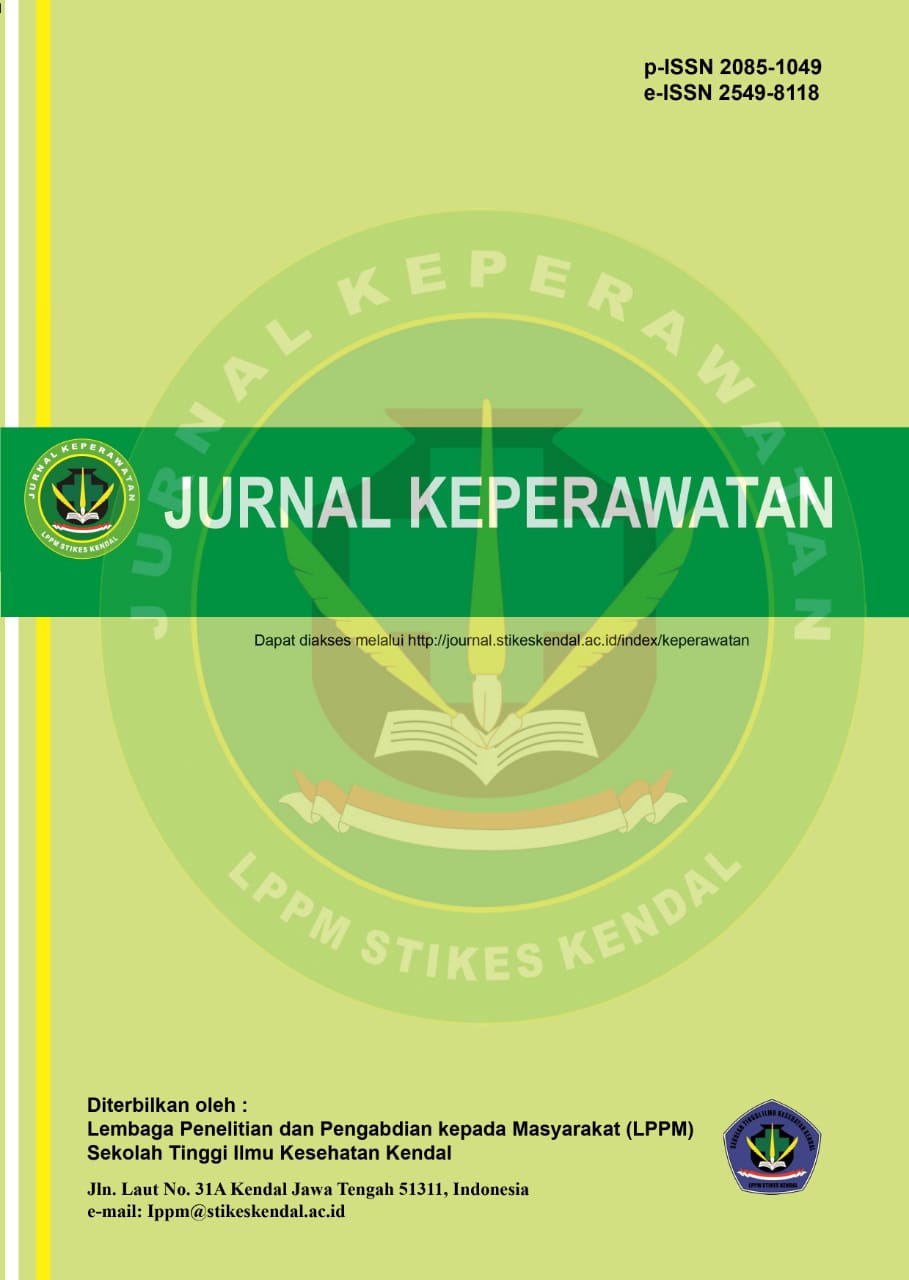Depresi Pasca Stroke (PSD): A Systematic Review
DOI:
https://doi.org/10.32583/keperawatan.v15i2.1026Keywords:
depresi, diagnosis, intervensi, strokeAbstract
Depresi pasca stroke (PSD) merupakan suatu gejala psikologis yang abnormal pada seseorang yang pernah menderita stroke. PSD ini juga merupakan komplikasi stroke dengan prevalensi 9-60% yang ditandai dengan abnormalitas mood, menyalahkan diri sendiri, kesedihan, dan depresi. PSD merupakan faktor utama yang menghambat penyembuhan fungsi neurologi dan aktivitas harian pasien stroke. Tujuan dari penelitian adalah untuk mengetahui gejala awal PSD dan intervensi PSD. Metode: menggunakan metode pencarian literatur dengan tinjauan sistematis (PRISMA) sebagai standar untuk melakukan tinjauan sistematis. Pencarian artikel dilakukan di database elektronik termasuk Science Direct, Pubmed dan Proquest, Google Scholar. Kata kunci yang peneliti digunakan adalah Depresi, Diagnosis, Intervensi dan stroke. Kriteria artikel terpilih adalah 1) terbitan tahun 2018-2022 2) teks lengkap 3) artikel dalam bahasa Inggris dan bahasa Indonesia. Artikel dipilih sesuai dengan kriteria dan total 8 artikel dari 5415 artikel diperoleh dengan PRISMA. Tinjauan sistematis ini menemukan bahwa ada banyak jenis instrumen untuk mendeteksi gejala depresi pasca stroke dan intervensi yang tepat sesuai dengan tingkat depresi. Namun di sisi lain, tingginya prevalensi PSD ini adalah karena tidak terdeteksinya gejala awal depresi oleh si care giver sehingga memperburuk kondisi si penderita stroke. Pasien paska stroke sebagian besar mengalami depresi berat. Oleh karena itu perlu adanya program untuk memberikan edukasi kepada pasien stroke dan keluarga dalam mencegah terjadinya depresi baik di tatanan klinik maupun masyarakat.
References
Alford, B., & Beck, A. (2009). Depression : Causes and Treatment. University of Pennsylvania Press.
Asmilia, L., Septiawantary, R., & Nuraenah. (2021). Depresi pada Pasien Pasca Stroke. Indonesian Journal of Nursing Sciences and Practices, 2(1), 27–32.
Ayerbe, L., Ayis, S., & Wolfe. (2013). Predictors and outcomes of depression after stroke: systematic review and metaanalysis. Br J Psychiatry, 14–21.
Biesbroek, J. M., J, van Z. M., & Kappelle, L. J. (2016). Shared and distinct anatomical correlates of semantic and phonemic fluency revealed by lesion-symptom mapping in patients with ischemic stroke. Brain Struct Funct, 221, 2123–2134.
Brockmeier, A. J., Ju, M., Przybyła, P., & Ananiadou, S. (2019). Improving reference prioritisation with PICO recognition. BMC Medical Informatics and Decision Making, 19(1), 1–14. https://doi.org/10.1186/s12911-019-0992-8
Budiantono, A., Sari, R., & Pratama, R. S. (2022). FAMILY SUPPORT ON DEPRESSION IN ELDERLY PATIENTS POST. Jurnal Ilmiah Kesehatan, 11(1), 176–182.
Chen, Y., Yu, L., & Shiau, M. (2020). The effects of health education on disease cognition, social support, and burden of main caregivers of stroke patients. the effects of health education on disease cognition, social support, and burden of main caregivers of stroke patients. Chang Gung Nurs.
Davison, G., M, N., & Kring. (2012). Psikologi Abnormal (9th ed.). PT. Raja Grafindo Persada.
Dong, L., Brown, D. L., Chervin, R. D., Case, E., Morgenstern, L. B., Lisabeth, L. D., Arbor, A., Arbor, A., & Arbor, A. (2022). HHS Public Access. 325–329. https://doi.org/10.1016/j.sleep.2020.04.025.Pre-stroke
Husseini, N. El, Hackett, M. L., Jorge, R. E., Kissela, B. M., Mitchell, P. H., Skolarus, L. E., Whooley, M. A., & Williams, L. S. (2017). AHA / ASA Scientific Statement Poststroke Depression. 30–43. https://doi.org/10.1161/STR.0000000000000113
Kelly, H. M. (2010). Influence of Age and Health Behaviors on Stroke Risk : Lessons from Lungitudinal Studies. Journal of American Geriatrics Society, 58, 325–328.
Khedr, E. M., Abdelrahman, A. A., Desoky, T., Zaki, A. F., & Gamea. (2020). Post Stroke Depression : Frequency, RiskFactors, and Impact on Quality Life Among 103 Stroke Patients - Hospital Based Study. The Egyptian Journal of Neurology, Psychiatry and Neurosurgery, 56(66).
Kruithof, W. J., MW, P., & Leeuwen, C. M. van. (2015). Course of social support and relationships between social support and patients’ depressive symptoms in the first 3 years post-stroke. Journal Rehabil Med, 47, 599–604.
Lin, F. H., Yih, D. N., Shih, F. M., & Chu, C. M. (2019). Effect of social support and health education on depression scale scores of chronic stroke patients. Medicine, 98(44), e17667. https://doi.org/10.1097/MD.0000000000017667
Oros, R., Popescu, C. A., Lova, S., & P, M. (2016). Depression Activities of Daily Living and Quality of Life in Elderly Stroke Patients. International Journal of the Bioflux Society, 24–28.
Pribadhi, H., Putra, I. . K., & Adnyana, M. O. (2019). Perbedaan Kejadian Depresi Pasca Stroke Pada Pasien Stroke Iskemik Lesi Hemisfer Kiri dan Kanan di RSUP Sanglah. Jurnal Medika, 8(3).
Robinson, R. G., & Jorge, R. E. (2017). Post stroke Depresion: Review. Journal of Psychiatry, 173(3), 221–231. https://doi.org/10.1176/appi.ajp.2015.1%0A5030363%0A
Septianingrum, J.H, J., & U, E. (2021). Analisis Sentimen Pada Isu Vaksin Covid-19 di Indonesia dengan Metode Naive Bayes Classifier. Jurnal Media Informasi Budidarma, 5(4), 1431–1437.
Shi, Y., Yang, D., Zeng, Y., & Wu, W. (2017). Risk Factor Post Stroke Depression : A Meta Analysis. Journal Font Aging Neurosci, 9.
Sibbritt, Dvid, Bayes, J., Peng, W., Maguire, J., & Adams, J. (2022). Associations Between Fatigue and Disability, Depression, Health Related Hardiness and Quality of Life in People with Stroke. Journal of Stroke and Cerebrovaskular Disease, 31(7). https://doi.org/10.1016/j.jstrokecerebrovasdis.2022.106543
Stuart, G. wai. (2016). Prinsip Dan Praktik Keperawatan Kesehatan Jiwa. Elsevier.
Susilawati, A., Ratep, N., Putera, K., Neurologi, P., Psikiatri, S. M. F., & Neurologi, S. M. F. (2014). Depresi Pasca- Stroke : Diagnosis dan Tatalaksana. 41(12), 901–905.
Thomas, S. A., Drummond, A. E., Linclon, N. B., & Palmer, R. L. (2019). Behavioural activation therapy for post-stroke depression : the BEADS feasibility RCT. Journal Health Technology Assessment, 23(47). https://doi.org/10.3310/hta23470
WHO. (2017). Depression and other common mental disorders: global health estimates.
WHO : Cerebrovasculer Accident, (2018). https://doi.org/e-book Geneva
Zhao, L., Biesbroek, J. M., Shi, L., Liu, W., Kuijf, J., Chu, W. W. C., Abrigo, J. M., Lee, R. K. L., Leung, T. W. H., Lau, A. Y. L., Biessels, G. J., Mok, V., & Wong, A. (2018). Strategic infarct location for post-stroke cognitive impairment : A multivariate lesion-symptom mapping study. https://doi.org/10.1177/0271678X17728162
Downloads
Published
How to Cite
Issue
Section
License
Copyright (c) 2023 Jurnal Keperawatan

This work is licensed under a Creative Commons Attribution-NonCommercial-NoDerivatives 4.0 International License.




